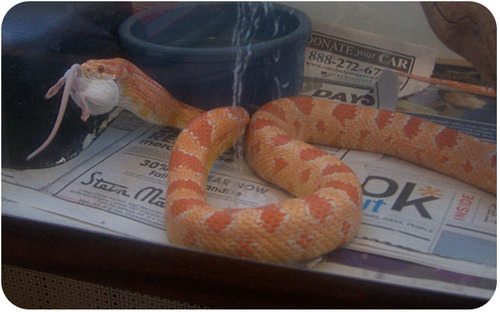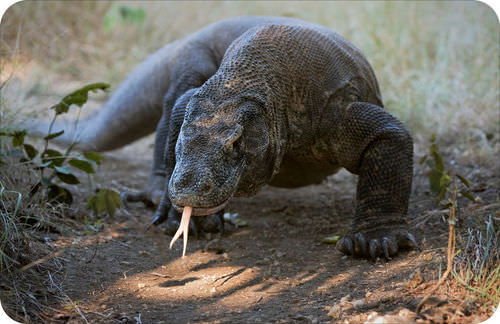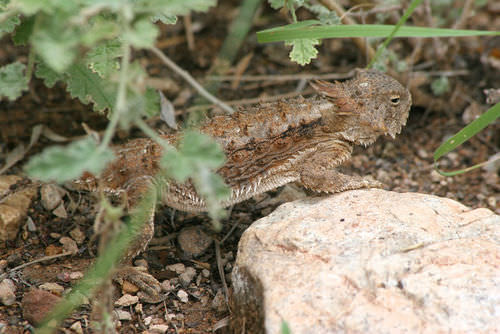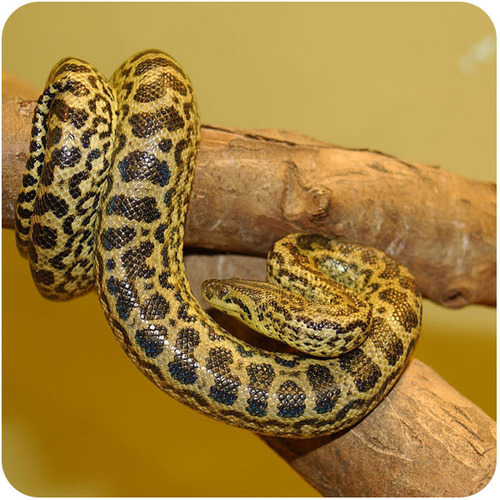10.12: Lizards and Snakes
- Page ID
- 14163

Are snakes deadly?
Some snakes are poisonous, but the majority of snakes are fairly harmless if they are left alone. This rat snake is actually beneficial to humans because it eats mice and rats, keeping those populations in balance. Some related species are so tame that they are often kept as pets.
Lizards and Snakes
Lizards and snakes belong to the largest order of reptiles, Squamata. Lizards are a large group of reptiles, with nearly 5,000 species, living on every continent except Antarctica. Some places are just too cold for lizards.
Characteristics of Lizards and Snakes
Lizards and snakes are distinguished by scales or shields and movable quadrate bones, which make it possible to open the upper jaw very wide. Quadrate bones are especially visible in snakes, because they are able to open their mouths very wide to eat large prey (Figure below). Without this ability, the snake diet would be very limited.

Characteristics of Lizards
Key features of lizards include:
- Four limbs.
- External ears.
- Movable eyelids.
- A short neck.
- A long tail, which they can shed in order to escape from predators.
- They eat insects.
Vision, including color vision, is well-developed in lizards. You may have seen a lizard camouflaged to blend in with its surroundings. Since they have great vision, lizards communicate by changing the color of their bodies. They also communicate with chemical signals called pheromones.
Adult lizards range from one inch in length, like some Caribbean geckos, to the nearly 10-foot-long Komodo dragon (Figure below).

With 40 lizard families, there is an extremely wide range of color, appearance, and size of lizards. Many lizards are capable of regenerating lost limbs or tails. Almost all lizards are carnivorous, meaning they eat animals, although most are so small that insects are their primary prey. However, some have reached sizes where they can prey on birds and mammals. On the other hand, a few species of lizards exclusively eat plants.
Lizard Behavior
Have you ever tried catching a lizard? Many lizards are good climbers or fast sprinters. Some can run on two feet, such as the collared lizard. Some, like the basilisk, can even run across the surface of water to escape danger. Many lizards can change color in response to their environments or in times of stress (Figure below). The most familiar example is the chameleon, but more subtle color changes can occur in other lizard species.

Legless Lizards
Some lizard species, including the glass lizard and flap-footed lizards, have evolved to lose their legs, or their legs are so small that they no longer work. This provides these species an evolutionary advantage in their way of life. Legless lizards almost look like snakes, though structures leftover from earlier stages of evolution remain. For example, flap-footed lizards can be distinguished from snakes by their external ears.
Characteristics of Snakes
Snakes are different from legless lizards because they do not have eyelids, limbs, external ears, or forelimbs. The more than 2,700 species of snake can be found on every continent except Antarctica and range in size from the tiny, 4-inch-long thread snake to pythons, to the over 17-foot-long anaconda (Figure below).
In order to fit inside of snakes’ narrow bodies, paired organs, such as kidneys, appear one in front of the other instead of side by side. Snakes’ eyelids are transparent “spectacle” scales which remain permanently closed. Most snakes are not venomous, but some have venom capable of causing painful injury or death to humans. However, snake venom is primarily used for killing prey rather than for self-defense. Snakes that are kept as pets can have their venom removed without affecting the health of the snake.

Most snakes use specialized belly scales, which grip surfaces to move (Figure below). In the shedding of scales, known as molting, the complete outer layer of skin is shed in one layer (Figure below). Molting replaces old and worn skin, allows the snake to grow, and helps it get rid of parasites such as mites and ticks.


Although different snake species reproduce in different ways, all snakes use internal fertilization, where fertilization of the egg takes place inside the female. The male uses sex organs stored in its tail to transfer sperm to the female. Most species of snakes lay eggs, and most species abandon these eggs shortly after laying them.
How do Snakes Eat?
All snakes are strictly carnivorous, eating small animals including lizards, other snakes, small mammals, birds, eggs, fish, snails, or insects. Because snakes cannot bite or tear their food to pieces, prey must be swallowed whole. Therefore, the body size of a snake has a major influence on its eating habits. A snake can usually estimate in advance if a prey is too large.
The snake’s jaw is unique in the animal kingdom. Snakes have a very flexible lower jaw, the two halves of which are not rigidly attached. They also have many other joints in their skull, allowing them to open their mouths wide enough to swallow their prey whole.
Some snakes have a venomous bite, which they use to kill their prey before eating it. Other snakes kill their prey by strangling them, and still others swallow their prey whole and alive. After eating, snakes enter a resting stage, while the process of digestion takes place. The process is highly efficient, with the snake’s digestive enzymes dissolving and absorbing everything but the prey’s hair and claws!
Summary
- Snakes and lizards are both in the order Squamata, distinguished by horny scales or shields and movable quadrate bones, which make it possible to open the upper jaw very wide.
- Snakes are different from legless lizards because they do NOT have eyelids, limbs, external ears, or forelimbs.
Explore More
Use the resources below to answer the questions that follow.
Explore More I
- Lizards, Snakes, and Poisonous Animals Roaming the Deserts of Australia at http://www.youtube.com/watch?v=bWfslaxznGw (3:01)
- How many species of reptiles can be supported by a single sand dune in the Australian desert?
- Are there more mammals or reptiles in the Australian desert?
- How does the physiology of reptiles and mammals explain their observed abundances in the Australian desert?
- Where do goanna lizards (Varanus spp.) lay their eggs? What about the environment they live in leads them to choose this location?
Explore More II
- Amazing Arctic Snakes Mating and Fighting - Deadly Vipers at http://www.youtube.com/watch?v=7TF7d4jvays (3:50)
- How many months a year are snakes active above the Arctic Circle?
- Why is black a good color for snakes above the Arctic Circle? How does this explain why the black snakes tend to be bigger than the zigzag patterned snakes?
- Why is it advantageous for females above the Arctic Circle to be black? Consider how this impacts their reproductive success.
Review
- List three characteristics of lizards.
- How are snakes different from legless lizards?
- How do snakes eat? Describe the snake jaw.

